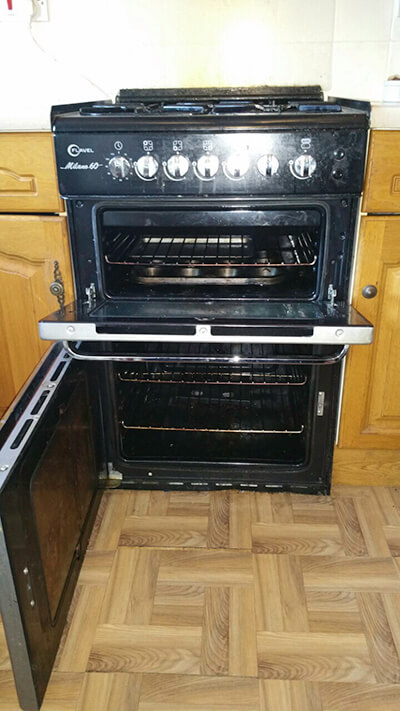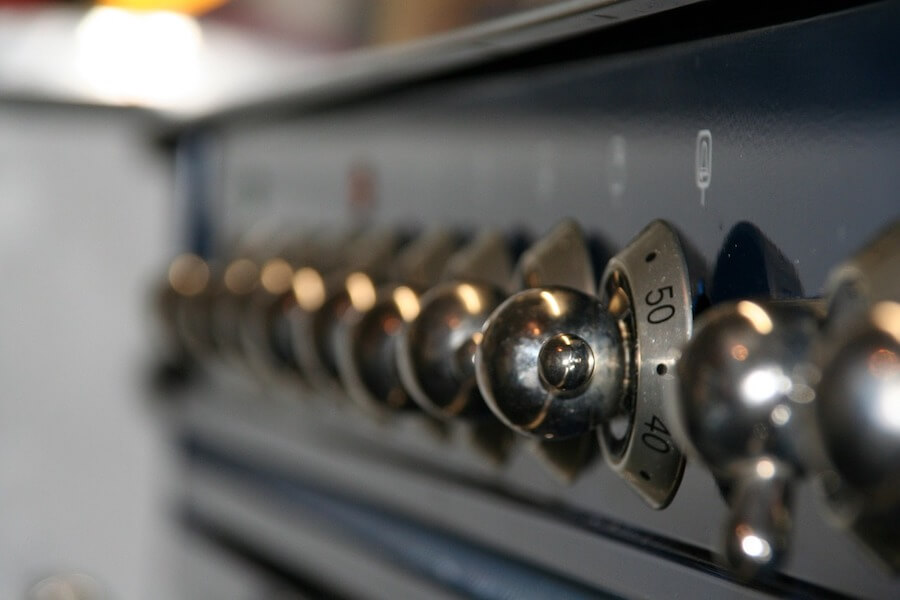These days there is almost no property without oven in the kitchen and cleaning it, requires lots of effort, especially if it is frequently used. For most people, it is one of the most challenging domestic cleaning tasks, but if you follow the next few oven cleaning tips, you will find out how easy this process can be.
One of the best inventions ever was the self cleaning oven. With ultra high heat, all the grime and food bits are incinerated and the oven is clean once again. For those of you who need to clean the oven by hand, though, here are some cleaning tips to make this time consuming and grimy chore a little more manageable.
How To Start Cleaning Your Single, Double or Range Oven
 Ovens vary in types, models and colours, but they could be cleaned using the same techniques. To start with, you will need an oven cleaning product, scourer pad, a brush, sponges, cloths, washing up liquid and clean water.
Ovens vary in types, models and colours, but they could be cleaned using the same techniques. To start with, you will need an oven cleaning product, scourer pad, a brush, sponges, cloths, washing up liquid and clean water.
As with most cleaning projects, the first tip for oven cleaning is to start at the top and work your way down. First take off all of the knobs and throw them into a pan with a little detergent and water to soak while you clean the rest of the oven.
Remove the trays and racks from the oven, place them in the sink and use the oven cleaning product to spray them with. Leave the product for about half an hour, then start scrubbing with the scourer pad and the brush and when all the food leftovers have gone, wash with a washing up liquid and a sponge as many times as needed for all the grease to be cleaned. You are done with the first part, then move on to the oven itself.
Broiler pans and drip plates under the burners can be lined with aluminium foil (like Mom used to do) or soaked once a week and scrubbed clean. The aluminium foil is easier in the long run. My favourite cleaning tip for broiler pans is to soak them right away in the sink while you finish dinner, and then wipe and rinse. Induction ovens have no burners, as the elements are located under the enamel. The top just heats up. The big question is how to wash these without scratching them. The answer is to wipe as soon as the element cools down enough to touch. Spray with window cleaner and wipe.
Wipe down the front, sides and top with a non abrasive detergent and cloth. The enamel is made of glass and steel fusion, and while heat resistant, it isn’t scratch resistant. Here’s a cleaning tip: Acidity plays a part as well so make sure if you spill tomato sauce or the like to wipe it off with a dry paper towel right away.
How To Clean The Inside Of An Oven Without Harsh Chemicals
Cleaning the inside of an oven is one of the least liked domestic cleaning jobs. I’ve got a confession to make: I hate cleaning the inside of an oven so much that I only really do it when it’s time for the annual deep clean… and even then, I tend to get a professional oven cleaning company in London to do it.
The reason for this is not because it’s a tough job that involves lots of elbow grease and grime to remove – well, not just because of this reason. It’s because I hate that horrible super-strong chemical spray stuff that you’re supposed to put into the oven to clean it. The fumes are absolutely vile, and I would really rather not have to buy (let alone use) something that requires the use of rubber gloves (which often have to be disposed of afterwards) and a face mask. Isn’t there a natural method for cleaning ovens?
There is, but be warned: it involves a lot of elbow grease. It also involves microfibre cloths of the Enjo type (specifically, it needs the green sort of cloth suitable for greasy stuff, if you are not used to Enjo colour-coding). Tune the radio to the sports station or get a talking book, as the job may take a while and you will need something to listen to while you work.
Start by getting a nice, big oven-proof dish or roasting pan. Fill it with boiling water. Put it in the oven and close the door. Turn on the oven fairly high and let the water boil. Keep topping the water up (open the door with caution) so you get 1–2 hours of steam. Set it up once you’ve finished doing dinner for the evening, as once the two hours are up, you will need to leave the oven overnight after the steaming session. Leave the oven turned off!
Next morning once the oven is cold, open the door and get out your microfibre cloth. Remove the oven trays. Start the job of rubbing around the inside of the stove with the cloth. You may need to use some baking soda to help you, as this also helps cut the grease. Have a bucket of warm water handy, as you may need to rinse out the cloth a few times – or have several cloths. There is no denying that this is a long job. If your oven is particularly foul, you may need to repeat the whole process, steam and all, several times. When all is looking grim, console and encourage yourself with the facts that (a) you won’t have to go to the gym, as you’re getting a great upper body workout, and possibly working your quads if you have to squat, and your cores if you twist around into odd positions; (b) you aren’t breathing in vile corrosive chemicals or adding them to the air or water.
You won’t need to clean the heating elements themselves – these are self-cleaning, as they burn off any splatters and spills.
The oven trays are a lot easier to clean. Line a big basin (the laundry sink is ideal) with aluminium foil. Pour in hot water. Add a cup of baking soda. Put the racks in, making sure that each one touches the aluminium foil somewhere. Leave them to soak for a couple of hours. Then rub them down with a cleaning cloth of some sort (microfibre optional). Dry well before replacing in the oven.
How to Clean the Inside of an Oven the Conventional Way
Depending on the type of oven, you may need to preheat it, but most of the ovens will not require it. Spray oven cleaner inside the oven and wait for at least fifteen minutes before you start scrubbing. Using gloves is recommended, to avoid skin irritations and allergies. If your oven cleaner is strong enough, you will be able to clean the grease by wiping it down with a sponge, but where required use the scourer pad to scrub it until it is completely clean. Then you need to rinse the oven with a warm clean water and at the end absorb the water with a soft cloth.
Traditional chemical oven cleaners all work well, just use enough of it so it will soak and be easy to wipe off, allow it to sit long enough to work before attempting to clean, and always wear gloves. Anyone with a cut on their hand who has touched oven cleaner can vouch for this! Follow the directions on the can and remove all racks to soak in hot, sudsy water.
The final part is to clean the oven glass. It is probably the easiest task as dirt comes off glass surfaces easier. Use the oven cleaner, spray the glass from inside and scrub with a sponge or a scourer pad. Wash with clean water and use a paper towel to polish it. After you are done, clean the oven from the outside with a soft cloth or paper towel and a glass cleaner to make it shine.
Preventing Is Key to Keeping an Oven in Pristine Condition
Of course, another tip is the best way to clean the oven – with prevention. Wipe down spills as they happen. To loosen grime in between deep cleans, place an oven safe bowl of boiling water in the oven and let sit for fifteen minutes. This will cause some of the crud on the sides to loosen and can be scrubbed up easier. (The same principle is used when you put a cup of water in the microwave and set it on high for one minute.) It is best to wipe up spills as they happen in a warm oven, if the food bakes on, it can be difficult to scrape off.
After you’ve spent all that time cleaning the oven, the last tip to keep it from happening again is by lining as much of the bottom of the oven as you can with aluminium foil. As long as you don’t let it touch the elements you will find that it helps tremendously with keeping the oven clean.
In case you are a tenant in a big city like London and you are moving out of your rented property then an end of tenancy cleaning London would most likely include an oven clean, at least this is covered by Anyclean.
Interested? Why don’t you call 020 7099 6964 and find out how we can help.

